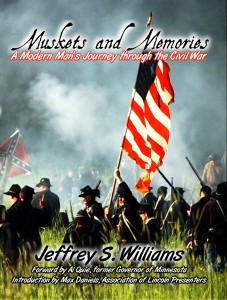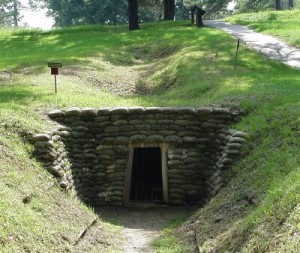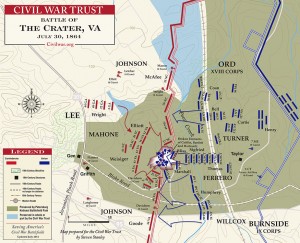by Jeffrey S. Williams
Excerpted from Muskets and Memories: A Modern Man’s Journey through the Civil War
By late-June 1864, Pennsylvania coal miners in the 48th Pennsylvania Volunteer Infantry were discussing what they would do, if they were in charge, to help end the impasse between the two armies. These were the kinds of discussions that most soldiers have when they are in situations like this, even those serving in the military today. The hair-brained schemes they come up with usually come across as something that would never work, never get considered by leadership, and then die a quick death. This idea was to simply dig a tunnel underneath the enemy lines, pack it with explosives and detonate it. After all, the regiment was composed of experienced coal miners from Pennsylvania’s Schuylkill County. In fact, Lieutenant Colonel Henry Pleasants himself spent time as a mining engineer before the war.1
After discussing this with two other engineers, Pleasants brought the matter up to the attention of Brigadier General Robert Brown Potter, commander of the 2nd Division of the IX Army Corps, who requested that Pleasants and a staff officer identify the potential target for a breech in the Confederate lines. Potter wrote the following in a memorandum to Major General Ambrose Burnside, IX Corps commander, “The men themselves have been talking about it for some days and are quite desirous, seemingly, of trying it. If there is a prospect of our remaining here a few days longer I would like to undertake it. If you desire to see Colonel Pleasants I will ride over with him or send him up to you. I think, perhaps, we might do something, and in no event could we lose more men than we do every time we feel the enemy.” Potter and Pleasants were summoned to the Corps commander’s tent on the morning of June 25, just two days after Pleasants first heard about the idea.2
During the meeting, Pleasants estimated that construction would take twelve days once he had all of the tools and supplies necessary, plus six tons of black powder to load into the mine for detonation. Despite some difficulty in his relationship with Major General George G. Meade, Army of the Potomac commander, Burnside gave his consent to begin the preliminary work on the project. Burnside was able to get the final approval for the project from Generals Meade and Grant.3
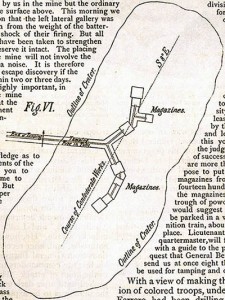 Pleasants had his men start the work at midnight on June 25 by clearing away some brush from a gully behind the Union trench line and out of Confederate view. After one day of work, the mine’s construction advanced fifty feet, partially induce by the promise of a whiskey ration for each 2.5 hour shift a man completes. The tunnel progressed another forty feet each day, though the whiskey ration was cancelled after the first week. They ran into problems on July 2, when the tunnel’s progress reached 250 feet as they ran into a soft clay formation that nearly collapsed the shaft. The colonel ordered them to dig at an incline figuring that they would get out of the clay and it would provide some drainage for the excess water. He was right on both accounts and the work was resumed.4
Pleasants had his men start the work at midnight on June 25 by clearing away some brush from a gully behind the Union trench line and out of Confederate view. After one day of work, the mine’s construction advanced fifty feet, partially induce by the promise of a whiskey ration for each 2.5 hour shift a man completes. The tunnel progressed another forty feet each day, though the whiskey ration was cancelled after the first week. They ran into problems on July 2, when the tunnel’s progress reached 250 feet as they ran into a soft clay formation that nearly collapsed the shaft. The colonel ordered them to dig at an incline figuring that they would get out of the clay and it would provide some drainage for the excess water. He was right on both accounts and the work was resumed.4
Confederate Brigadier General Edward Porter Alexander, the Army of Northern Virginia’s I Corps chief of artillery, thought something was amiss during this time. Alexander had experience in espionage early in the war and noticed that there wasn’t a major trench network built up by the Federals near Elliott’s Salient like there had been elsewhere in the lines, plus the activity of the volleys that were exchanged along that section was more frequent than other sections. The general suspected that some type of underground activity was being conducted and notified General Lee just before the artillery chief departed for a convalescent leave after getting wounded in the hand by a Federal sharpshooter.
Lee Detailed Captain Hugh Douglas, an engineer, with the task of constructing countermines to detect possible Federal mining activity. The Confederate operation was similar to their Union counterparts in the methodology, though terrain and experienced personnel proved to be bigger challenges for Douglas. Even though it appeared that the Confederate countermine operation might be successful, it suffered one serious shortcoming – Douglas failed to dig his mines deep enough.5
The living conditions and lack of food took its toll on the Confederate soldiers at Elliott’s Salient and desertion became a problem. Three deserters from the 49th North Carolina Infantry deserted and were questioned July 17. They disclosed to their Federal interrogators the presence of the Confederate countermine operation. Burnside had deduced that the Confederate operation was in the correct vicinity but was too shallow. Pleasants halted work on the Federal mine for a short time, entered the mine and listened himself, and then ordered his miners to quietly resume work on the side galleries where the powder was to be placed.6
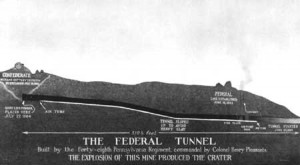 Pleasants mine was completed on July 23 after one month of continuous work. From its entrance to the Confederate lines, the tunnel was 511 feet long. The left gallery was thirty-seven feet from the main tunnel while the right gallery was thirty-eight feet from the main. 18,000 cubic-feet of Virginia soil was excavated, all out of the sight of the Confederates. Only one problem remained for the Pennsylvania coal miners, the black powder had not arrived yet.7
Pleasants mine was completed on July 23 after one month of continuous work. From its entrance to the Confederate lines, the tunnel was 511 feet long. The left gallery was thirty-seven feet from the main tunnel while the right gallery was thirty-eight feet from the main. 18,000 cubic-feet of Virginia soil was excavated, all out of the sight of the Confederates. Only one problem remained for the Pennsylvania coal miners, the black powder had not arrived yet.7
A wagon train arrived on July 27 containing 320 kegs of black powder. Each keg weight twenty-five pounds, which meant that eight thousand pounds (four tons) of explosives would be used in the operation instead of the six tons that was originally requested. A work detail ensued that had required the laborers to carry two kegs, each one concealed in a canvas sack, over a mile from the wagon train to the mine’s entrance. Miners then hauled the cargo down the shaft, opened the kegs carefully and poured the black gold into the wooden magazines and connecting troughs in each of the four chambers. Six hours after the process began, the last keg was emptied.8 The mine was completely ready for detonation at 6 P.M. on July 28, once the fuses were put into place and the tamping process completed.9
At 3:15 A.M. on the morning of July 30, Lieutenant Colonel Pleasants lit the fuse. The battle plans were in place, authorization was given, mine was complete and the waiting now began. After an hour with no explosion, Sergeant Harry Reese of Company F, and Lieutenant Jacob Douty of Company K, volunteered to go into the tunnel and figure out the cause of the delay. They discovered that the fuse was extinguished where two lengths of fuse were spliced together. They re-lit the fuse, exited the mine and waited for another half hour. At 4:44 A.M., the flame from the fuse reached the four-tons of black powder.10
***
Captain Sam Harriman of the 30th Wisconsin Volunteer Infantry Company A was tasked with raising a new regiment, in March 1864. Harriman was from Somerset, in nearby St. Croix County, not far from the Wisconsin-Minnesota border. He was promoted to the rank of colonel, and had a full regiment mustered for service within two months. They were designated as the 37th Wisconsin Volunteer Infantry. Though they were still green troops with very little training, the newest regiment of Midwesterners was already in the field guarding a supply wagon from White House Landing on the James River in Virginia to Cold Harbor, northeast of Richmond, by mid-June, only two weeks after the bloody battle at that site. They were attached to the 1st Brigade, 3rd Division of the IX Army Corps.11
They arrived at the front lines of the Siege at Petersburg late in the afternoon on June 16, and were immediately ordered to move out to support a charge that was to be attempted by another division, though their services were not needed. They tasted combat for the first time the very next day at the Battle of Hare Hill, suffering their first major casualties with forty-four killed in action and ten who later died of wounds.12
On the morning of July 30, when the mine built by the 48th Pennsylvania exploded, the men of the IX Corps were prepared to make their advance upon the Confederate salient. “At that time a vast column of smoke mingled with earth, fragments of guns and platforms, logs, sand-bags, gabions and human beings shot towering into the air to an immense heights, gradually subsiding again and followed immediately by a dull, smothered roar which shook the ground for miles round, and was said to have been felt even to City Point,” wrote Major Robert C. Eden of the 37th Wisconsin shortly after the battle. “A pause, in which one might count, perhaps a dozen beats at the wrist, and 85 pieces of heavy artillery opened almost simultaneously on the rebel lines. The enemy was no slow in replying, and soon the light artillery and musketry chimed in, making the noise completely deafening, and the very ground under our feet to vibrate.”13
The Confederates were surprised and panic-stricken immediately after the explosion but still had enough time to regroup and recover by the time the order was given to the Federal troops to charge, which Eden states was a period “for some minutes.” When the regiment finally attacked, Colonel Harriman and Adjutant C.I. Miltimore led the effort to capture and turn two Confederate artillery pieces against their former owners, but they were recaptured as “the whole place soon became a perfect slaughter house.” The battle lasted until 4 P.M. before the Federal troops withdrew back to their original positions.14
The regiment sent 250 soldiers into the battle that morning but only ninety-five attended the roll call that evening. The rest were killed, wounded or missing. Among the dead were at least six Ojibwe Indian privates that served in Company K: Semour Hah-pah-ton-won-i-quette; Meshell Kenosha; Amable Nah-she-kah-appah; Dominique Teco; and Felix Wah-ton-nut plus Benjamin Rubber, who died of wounds. At least six other Ojibwe were wounded and two were taken prisoner. The prisoners later died.15
The regiment was mustered out on July 26, 1865, and arrived in Madison¸ Wisconsin on July 31, 1865, one year and one day after their toughest engagement at the Battle of the Mine, their service now complete.16
Footnotes:
1. Corrigan, Jim. The 48th Pennsylvania in the Battle of the Crater: The regiment of coal miners who tunneled under the enemy. (Jefferson, North Carolina: McFarland & Company Inc., 2006), p. 21.
2. Ibid., pg. 22.
3. Ibid., pp. 22-28.
4. Ibid., pp. 33-35.
5. Ibid., pp. 39-41.
6. Ibid., pp. 43-44.
7. Ibid., pp. 44-45.
8. Ibid., pg. 47.
9. Gould, Joseph. The Story of the Forty-Eighth: A Record of the Campaigns of the Forty-Eighth Regiment Pennsylvania Veteran Volunteer Infantry during the four eventful years of its service in the war for the preservation of the Union. (Philadelphia: Alfred M. Slocum Company, 1908), p. 216.
10. Ibid., pg. 216.
11. Eden, Robert C., The Sword and Gun: A History of the 37th Wis. Volunteer Infantry, From its first Organization to its final Muster Out , (Madison, Wisconsin: Atwood & Rublee, 1865), pp. 7-16.
12. Ibid., pp. 18-23.
13. Ibid., pg. 29-30.
14. Ibid., pp. 31-32.
15. Ibid., pp. 32, 106-109.
16. Ibid., pp. 66-68.

